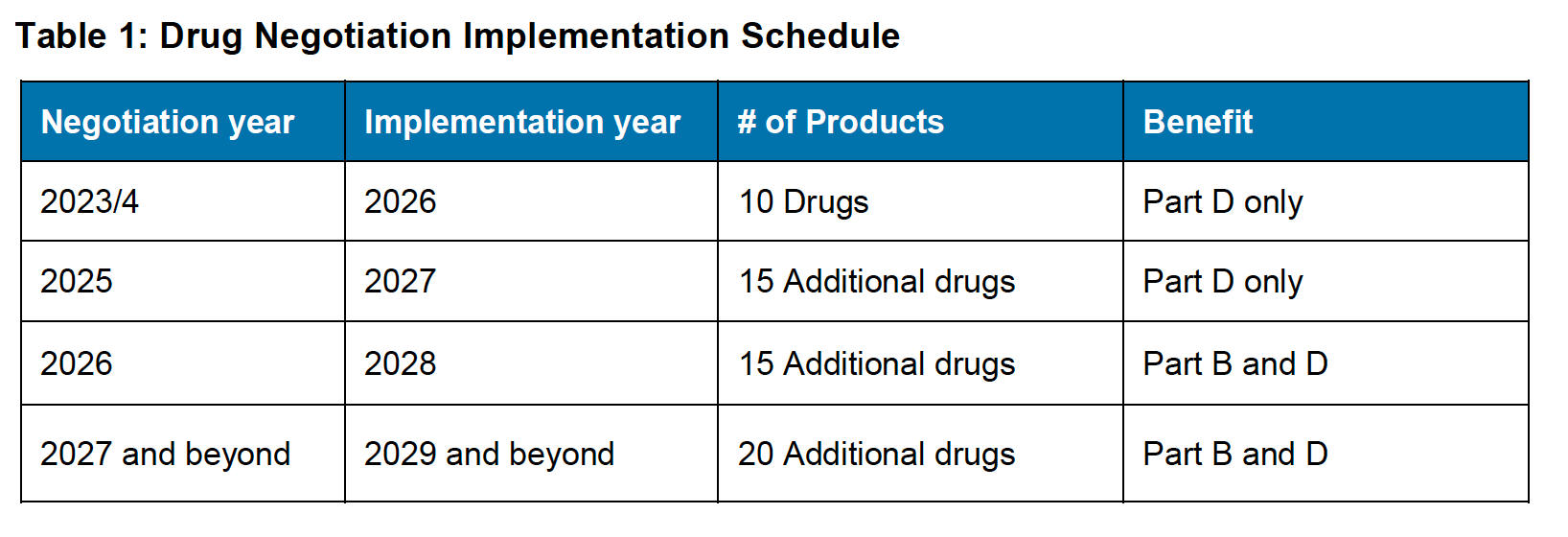Inflation Reduction Act: Adjustments to Medication Pricing and Reimbursement
In the second of a three part series about the Inflation Reduction Act, Matthew Majewski and Rhett Johnson of Charles River Associates review the provisions of the law that will affect medication pricing and reimbursement, including Medicare price negotiation.
Second of three parts
Matthew Majewski

Rhett Johnson

Note: Updated on Aug. 30, 2024.
The Inflation Reduction Act (IRA) of 2022 contains some of the most significant changes in healthcare regulation since the introduction of the Medicare Modernization Act of 2003. There are many healthcare-related policy changes contained in the IRA, which can be categorized into three major sections: expansion of patient access to affordable insurance, adjustments to medication pricing and reimbursement and reforms to patient cost sharing.
In this post, we are focusing on medication pricing and reimbursement. The IRA has four notable provisions in this area:
Medicare drug price negotiation
The most extensive change to pharmaceutical pricing in the IRA is a mandate that the Secretary of Health and Human Services (HHS) shall establish a Drug Price Negotiation Program (Program). This Program will empower Medicare to negotiate directly with manufacturers for the first time and, once price is negotiated, these drugs will appear on all Medicare formularies. As part of the Program, the HHS Secretary will publish a list of drugs for negotiation, enter into agreements to negotiate with manufacturers, negotiate “maximum fair prices”, and monitor and enforce compliance of the Program.
Initially, this Program will be limited to a set number of high expenditure drugs paid for by Medicare, but a variety of criteria will determine the drugs selected:
- Single-source drugs that were in the top-50 total expenditure drugs for Medicare Part B or D in the prior year
- FDA-approved drugs which have been approved for at least seven years and for which no generics have been approved (authorized generics do not count)
- FDA-approved biologics which have been approved for at least 11 years and for which there are no biosimilars (authorized biosimilars do not count and a delay in negotiation is possible if there is a “high likelihood” that a biosimilar willbe approved in the next two years)
Notably, the Program excludes:
- Qualifying orphan drugs, being those that have been designated as a drug for a single rare disease or condition – drugs with multiple indications could be included in the Program
- Low-spend Medicare drugs, being those with Medicare expenditures less than $200 million in 2023 increased by the Consumer Price Index for all Urban Consumers (CPI-U) for each subsequent year
- Biologic products derived from human blood or plasma
- For 2026 through 2028, drugs sold by small biotech manufacturers which are defined by having one product that accounts for most (>80%) of their revenue and less than 1% of Medicare spend
Table 1 below identifies by year how many additional drugs are to be selected for negotiation under which benefit.

The list of the first 10 products that will be subject to price negotiation was published on August 29, a few days ahead of the September 1 deadline, with subsequent lists scheduled to be published on February 1 of each following year. Presumably the first year begins earlier to give more time for manufacturers and HHS to acclimate to the Program.
Table 2 below provides a timeline by which negotiation or renegotiation is expected to follow.

HHS is expected to establish a consistent negotiation process which aims to achieve the lowest maximum fair price but the IRA states that HHS should consider factors such as:
o research and development costs
o current unit production and distribution costs
o prior federal financial support for discovery and development
o data on pending and approved patent applications and exclusivities
o market/revenue/sales volume data
o alternative treatment options and comparative effectiveness.
HHS and the manufacturer must agree to a maximum fair price, which is less than a ceiling price. These amounts are defined as follows in Table 3. The ceiling price is the lower of the two methodologies described below:

To ensure that manufacturers reach a negotiated agreement, a significant excise tax is to be applied during any period of noncompliance with the above-mentioned timelines. The excise tax is initially set at 65% of all US drug sales and increases to 95% of all US drug sales if a manufacturer remains out of compliance. Additional penalties are specified for providing false information, failing to provide the maximum fair price, and several other potential violations. Once a product has reached a negotiated maximum fair price with HHS, this price remains in effect until the year beginning nine months after a generic or biosimilar has entered into the market. The maximum fair price will be increased annually by the CPI-U and after the first two years of the Program, the Secretary may decide to renegotiate with drug manufacturers. Renegotiations are triggered by either:
- a change in monopoly status (e.g., from extended to long monopoly) or
- the approval of new indications or other material changes if the renegotiation is expected to result in a significant change in the maximum fair price.
Once a manufacturer has reached a negotiated maximum fair price, the Program will ensure that drugs for which prices have been negotiated are included on all Part D formularies and that Part B drugs are reimbursed at 106% of the maximum fair price (subject to sequestration). Further, the maximum fair price can set Medicaid Best Price but will not be part of Average Manufacturer Price (AMP) calculations. Finally, there is a provision whereby a manufacturer must offer the maximum fair price to 340B entities; however, the 340B entity must choose either the maximum fair price or their 340B discount.
Drug inflation rebates
The IRA will require manufacturers of certain single-source drugs to issue rebates to HHS for Medicare Part B and D expenditures on any drug that increases price faster than the CPI-U. The bill distinguishes between products covered under Medicare Part B and D as outlined below:
Medicare Part B
No later than six months after each calendar quarter, beginning January 1, 2023, HHS will provide manufacturers with a quarterly report detailing the number of units paid for during a relevant period, the excess increase in average sales price (ASP) relative to the inflation rate, and the rebate due to HHS. This provision of the IRA may begin on January 1, 2023, but HHS has the option to delay implementation for up to two years. Drugs launched after 2020 will have the rebate applied once ASP is established, which will occur on the sixth full calendar quarter after the drug is first marketed. These inflation rebates will be excluded from many forms of government price reporting (e.g., ASP, Best Price, AMP).
Medicare Part D
No later than nine months after each calendar year (defined as October 1 – September 30), beginning October 1, 2022, HHS will provide manufacturers with an annual report detailing the amount of excess annual price increase for each dose strength and form, and the rebate amount due to HHS. Like Medicare Part B, HHS may delay this first rebate period by up to two years and these rebates will be excluded from government price reporting (e.g., Best Price, AMP).
Delay of the pharmacy benefit manager safe harbor rebate rule
President Trump signed an executive order in 2020 directing the Secretary of HHS to remove the discount safe harbor protections in connection with the sale of pharmaceutical products adjudicated through pharmacy benefit managers (PBMs). This rule was originally intended to go into effect in January 2021; various legislative actions have delayed implementation. The IRA continues this trend by delaying any implementation of the rule until Jan.1, 2032.
Increased physician reimbursement for biosimilar biologics
To increase the adoption of biosimilar medications, the IRA temporarily increases physician payments on Medicare Part B biosimilars. The add-on payment for biosimilars was traditionally 6% of the reference product’s ASP; this is now enhanced to 8% of the reference product’s ASP. However, physician payment sequestration of 2% will continue to apply, reducing this add-on payment to 6.272% (compared to 4.304% today). This increase in the add-on payment began October 1, 2022 and is set to end on December 31, 2027.
In summary, the IRA has empowered the Federal Government to negotiate with manufacturers for high-budget products that have limited competition, implemented inflation-based rebates, further delayed the implementation of the PBM rebate safe harbor rule, and increased physician reimbursement for biosimilar drugs.
Implications for life sciences companies
- The Medicare Drug Negotiation Program is expected to have a significant impact on many blockbuster medications. A single-entity negotiation with a clearly established formula for a maximum fair price and a defined negotiation timeline is likely to significantly reduce the net price for many of the best-selling Medicare drugs.
- A minor benefit for Part D drugs selected for negotiation is that they will be covered on all Part D formularies. However, only being covered may not be adequate in some therapeutic categories and additional negotiation or communication with plan sponsors may be required.
- There will likely be significant disruption in each therapeutic area where a drug is selected for negotiation, as other Medicare rebates may need to increase to remain competitive with negotiated drugs for Part D formulary consideration.
- Similarly, it is likely that manufacturers may limit development of pipeline agents for therapeutic categories with negotiated products. We would expect to see some manufacturers already beginning to consider the future implications and adjusting their pipeline portfolios accordingly.
- Branded biologic manufacturers may need to monitor when biosimilars launch as this could impact when and if HHS may choose to negotiate on a particular product, given the restrictions on negotiation for biologics with biosimilars set to launch within two years.
- In an extreme example, it is possible that manufacturers may sell negotiated products to small companies who would choose to no longer sell in the Medicare space and only provide product to commercial patients.
- While drug inflation rebates are only being mandated for Medicare sales, commercial payers may attempt to follow this trend. Price protection is already a standard in many payer contracts and implementation of inflation-based rebates would be a natural extension of existing price protection provisions. The counterargument is that Medicaid inflation-based rebates have been in place for many years without private insurers following suit. The long-term impact of these rebates could be to slow the increase of the gap between list and net prices that have occurred as both list prices and payer rebates have risen. Manufacturers will be encouraged to price their products at launch considering the value of all possible future indications and considering the limited ability to increase prices throughout the product life cycle.
- Biosimilar manufacturers may see a temporary increase in net-cost recovery when their reimbursement is increased to ASP+8% (of the branded originator’s ASP) compared to branded originators who will only be reimbursed at ASP+6%. However, the relatively modest size of the increase may have only a moderate impact on physician prescribing.
Matthew Majewski and Rhett Johnson are vice presidents in the Life Sciences Practice at Charles River Associates, a global consulting firm.
Phase 3 Trial of Vertex’s Islet Cell Therapy for Type 1 Diabetes in Under Way
April 23rd 2025Zimislecel is an allogeneic stem cell-derived islet cell therapy that could eliminate the need for insulin in those who have type 1 diabetes. Regulatory submissions are expected in 2026, and if approved, would be the second cell therapy for type 1 diabetes.
Read More
Conversations With Perry and Friends
April 14th 2025Perry Cohen, Pharm.D., a longtime member of the Managed Healthcare Executive editorial advisory board, is host of the Conversations with Perry and Friends podcast. His guest this episode is John Baackes, the former CEO of L.A. Care Health Plan.
Listen
Breaking Down Health Plans, HSAs, AI With Paul Fronstin of EBRI
November 19th 2024Featured in this latest episode of Tuning In to the C-Suite podcast is Paul Fronstin, director of health benefits research at EBRI, who shed light on the evolving landscape of health benefits with editors of Managed Healthcare Executive.
Listen
Experts Explore Causes and Care for Chronic Itch
April 22nd 2025In a recent discussion with Managed Healthcare Executive, three leading dermatologists and itch experts—Shawn Kwatra, M.D., Brian Kim, M.D., and Gil Yosipovitch, M.D.—shared where the science is going, what’s holding it back and how the healthcare system can better support patients.
Read More